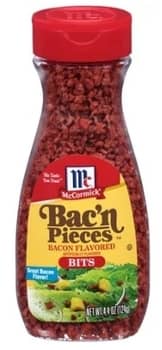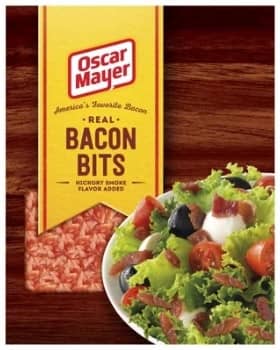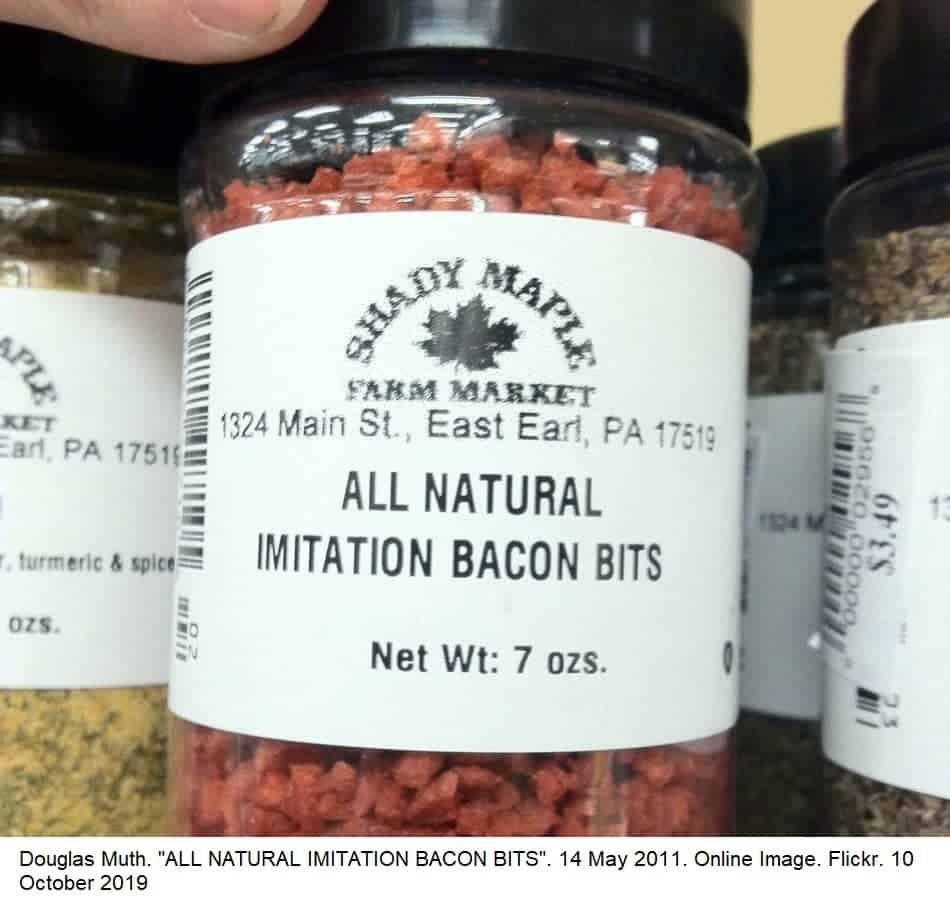Bacon bits are a popular topping for salad and a common ingredient in various recipes.1 It seems like anything with bacon in the name would automatically be rendered unsuitable for vegans and vegetarians.
Interestingly, there are numerous plant compounds that can impart a meat-like savory, or umami, flavor to foods. So, it’s not uncommon for meat-flavored products to be completely plant-based.
Are they vegan or vegetarian? Some bacon bits are vegan and vegetarian, while others are not. There are two types of bacon bits—one variety being small and crunchy, with the other being dry and chewy—like a bacon jerky. It’s the former that tends to be vegan.
There’s a third kind that’s a combination of the two, which means it’s also non-vegan. But, I’ve yet to come across these in stores.
What we’ll do here is go over the two main types of bacon bits currently on the market, so you’ll know which to consume and which to steer clear of.
Vegan/Vegetarian Bacon Bits
The artificial version of bacon bits did not come about to appeal to vegans. The popularity of bacon in the US has led to a number of commercial food products promising to provide an authentic bacon flavor without the laborious process of cooking and preparing actual bacon.
Another reason manufacturers produced artificial bacon-flavored bits, is to provide a healthier alternative to using real bacon. Red meat—especially, processed red meat—has long been thought to up the risk of cardiovascular disease and even cancer.2,3
So, food manufacturers got extra creative and came up with a product that imparts the bacon flavor without the negative qualities.
How did they do it?
Artificial bacon bits are considered a type of meat analog—a meat-like food product made from textured vegetable protein (TVP)—that’s been artificially flavored to resemble real bacon.4
If you see TVP or “textured vegetable protein” on labels, it basically means soy, though other substances can be used. Natural or artificial colors are also often added, usually Red 40 and caramel color.
Where does the bacon-like taste come from? Liquid smoke is common—it’s a substance derived from destructive distillation of wood. It’s hardly a healthy superfood, but it’s at least vegan-friendly.5
An example would be McCormick’s Imitation Bacon Bits.

These contain:6
- Texturized soy flour
- Canola oil
- Salt
- Caramel color
- Maltodextrin
- Natural and artificial flavorings
- Lactic acid*
- Yeast extract
- Disodium inosinate and disodium guanylate
- Red 40
Keep in mind lactic acid is not the same thing as lactose. The latter is always dairy-derived, while the former tends to be manufactured from LA-producing bacteria.7
Non-Vegan/Vegetarian Bacon Bits
Real Bacon
The other main type of bacon bits, usually called “real bacon bits” or “real bacon pieces”, are made from small, crumbled pieces of actual bacon.1
In commercial plants, they’re usually cooked in continuous microwave ovens. Similar products are often made from turkey or ham, but bacon seems to be the most common.
This kind has a much chewier mouthfeel, as opposed to the crunchy texture in the artificial variety. Again, it’s sort of like bacon jerky. If purchasing your own, these will be easy to spot, because the label will read “real bacon”.
If you’re eating homemade recipe—say, at a party or a friend’s house—then you’ll probably be able to tell from the texture. You’ll want to ask just to make sure.
I’d imagine this second type of bacon bits came about due to an increasing demand for “natural” food products. Artificial bacon bits acquired a reputation similar to Easy Cheese (a popular brand of artificial cheese used for spraying on crackers).
Though they’re not much healthier than fresh bacon (the fat content may be a bit lower), using real bacon at least allowed manufacturers to provide a genuine bacon flavor with all the convenience of artificial bacon bits, but without the stigma.
You might be wondering why they still make the vegan-friendly artificial kind. For one, the artificial kind is still considered healthier. Don’t get me wrong, they don’t exactly constitute a health food, but they are lower in saturated fat.
Secondly, the real bacon bits have a much shorter shelf life and usually require refrigeration which is a bridge too far for folks who like to stock their pantry with dry goods that last forever.
They’re also much cheaper.
Finally, they also don’t qualify for Kosher or vegetarian labels.
Thus, the artificial variety can still be found in most grocery stores.
An example of this kind would be Oscar Mayer Real Bacon Bits.

These contain:8
- Bacon cured w/ water, salt, sugar, sodium phosphates, sodium ascorbate, and sodium nitrite
- Hickory smoke flavor
- May contain potassium chloride and/or artificial maple flavor
Real Bacon Plus TVP
Here, the food manufacturers found a compromise—a way to get a longer shelf life and less fat while maintaining a real bacon flavor.
That’s right, some bacon bits have real bacon with a bit of TVP mixed in.
These bacon bits make for a mid-price item that offers some of the benefits from each of the above varieties.
A lot of folks assume that meat is either real or fake, but the reality is that manufacturers have long beefed up (or beefed down) real meat with soy and other textured vegetable proteins.
They found out pretty early on that the fat content of mechanically processed meat could easily be reduced by simply replacing some of the meat with low-calorie extenders like TVP or plant starches, fibers, and gums.9
That’s it for the vegan status of bacon bits. Thanks for reading.
You may also want to check out the following related articles:
References
- Where Does Bacon Really Come From? Peggy Filippone – https://www.thespruceeats.com/what-is-bacon-p2-1806994
- Sofia Bronzato and Alessandro Durante. A Contemporary Review of the Relationship between Red Meat Consumption and Cardiovascular Risk. Int J Prev Med. 2017; 8: 40. https://www.ncbi.nlm.nih.gov/pmc/articles/PMC5474906/#ref23
- Turesky RJ, Le Marchand L. Metabolism and biomarkers of heterocyclic aromatic amines in molecular epidemiology studies: Lessons learned from aromatic amines. Chem Res Toxicol. 2011;24:1169–214. https://www.ncbi.nlm.nih.gov/pubmed/21688801
- Textured Vegetable Protein. https://web.archive.org/web/20080723192124/http://www.diversifiedfoods.com/DFI_TexturedVegetableProtein_Frame.htm
- Liquid Smoke, Production. https://en.wikipedia.org/wiki/Liquid_smoke#Production
- McCormick Imitation Bacon Bits. https://www.mccormick.com/spices-and-flavors/other/bacn-pieces-bacon-flavored-bits
- Lactic Acid, Production. https://en.wikipedia.org/wiki/Lactic_acid#Production
- Oscar Mayer Real Bacon Bits, 9 oz Pouch. https://www.walmart.com/ip/Oscar-Mayer-Real-Bacon-Bits-9-oz-Pouch/40547611
- DeFreitas Z, et al. Carrageenan effects on salt-soluble meat proteins in model systems. Journal of Food Science 62(3):539–543, 1997.

